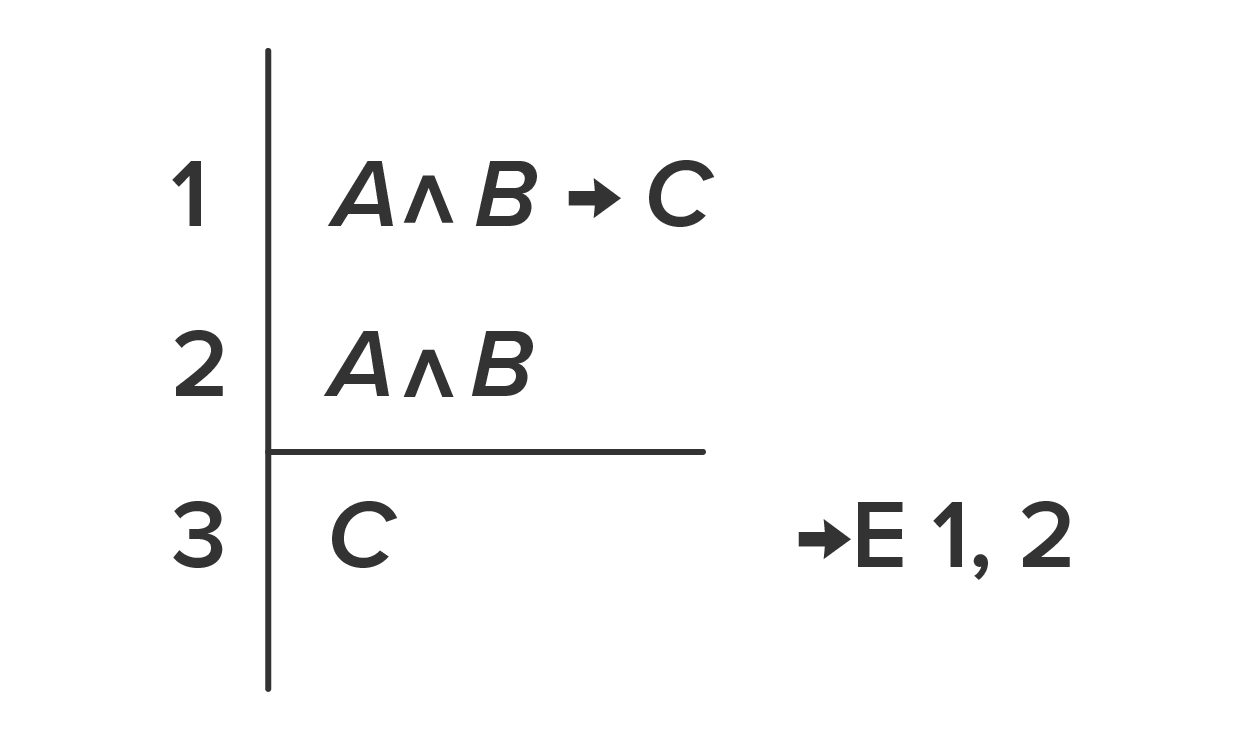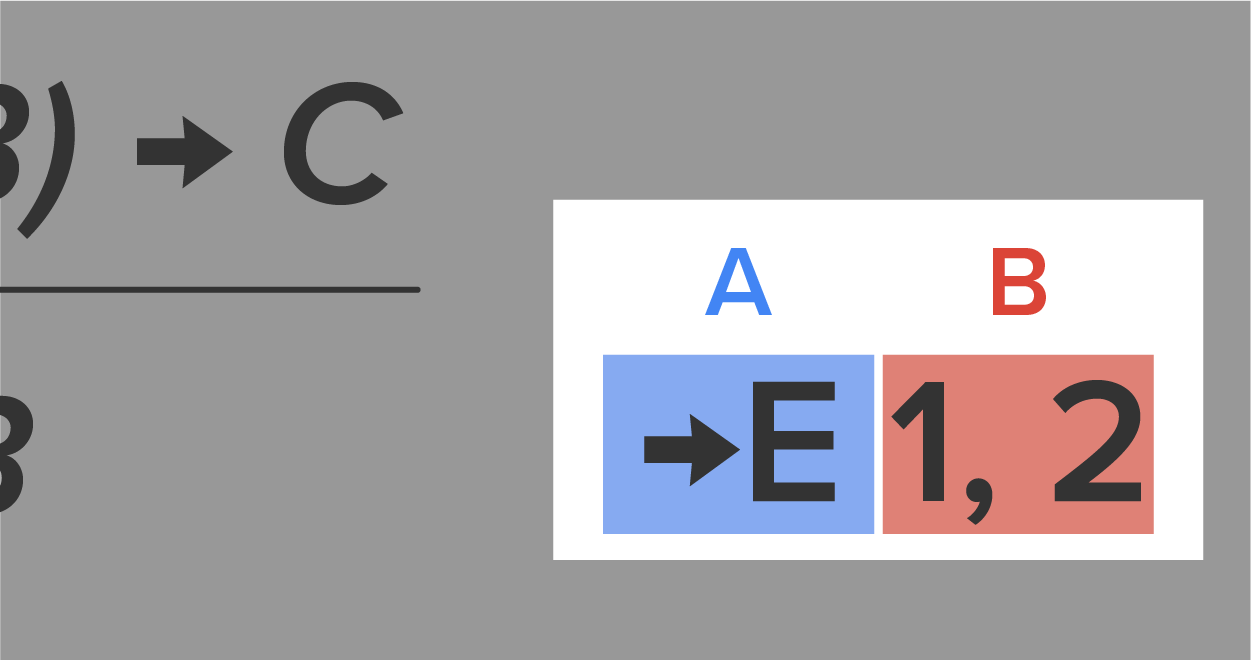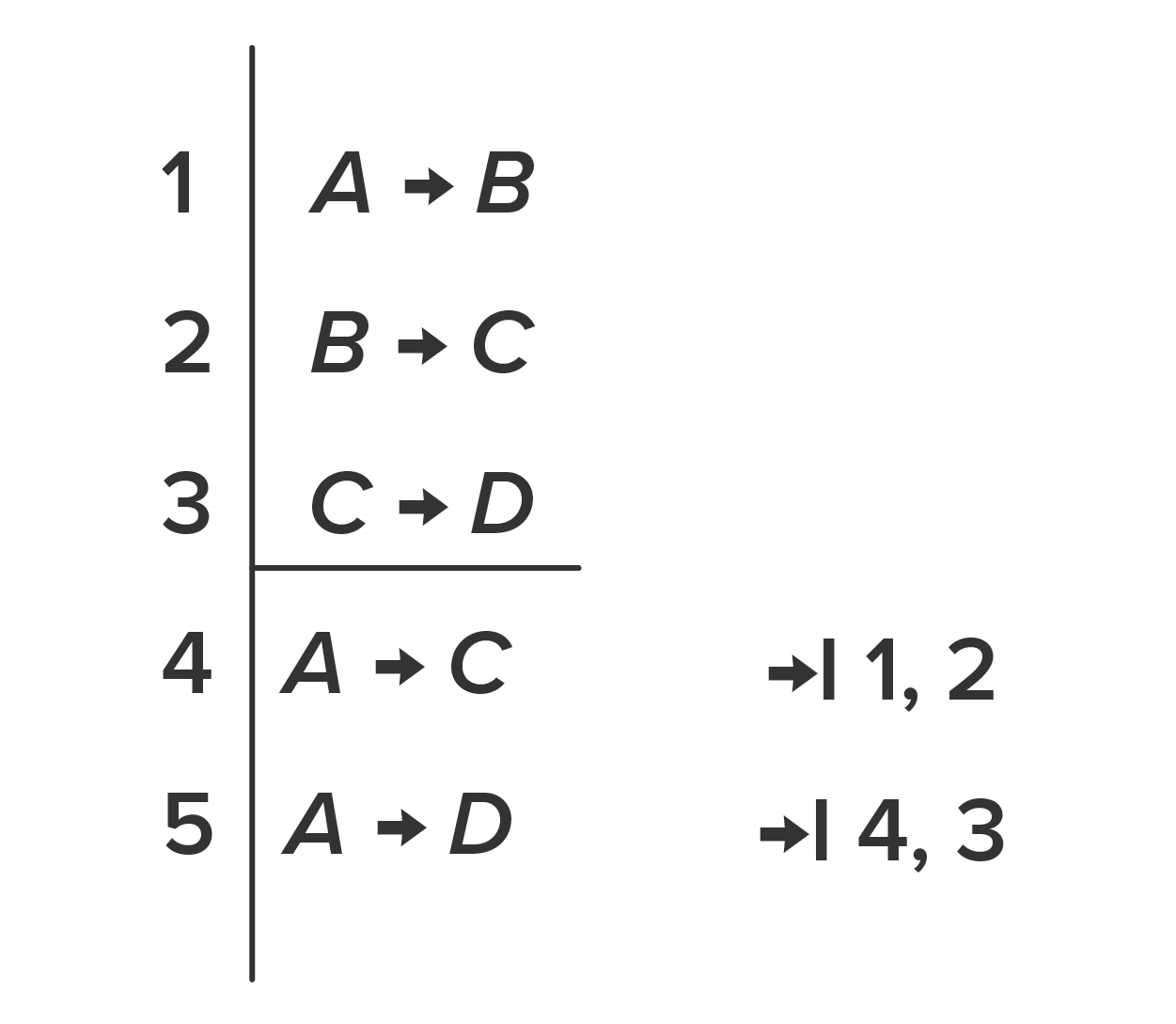Table of Contents |
We saw in the previous tutorial that a logic proof is essentially an argument where we “show our work,” and that this entails referencing rules that justify each derivation, or step in our reasoning. As you know, these are called rules of inference. We will learn eight of these rules in this class, which will be sufficient to construct many proofs. There is some disagreement among logicians about how many basic rules of inference there are, and an exhaustive list of rules could number around forty and is beyond the scope of the class. These eight will suffice for our purposes and are the classic rules for sentential logic.
In this tutorial, you will learn three rules of inference that pertain to conditional sentences; these three will be found on anyone’s list of basic rules of inference.
The rules of inference need to be so clear and straightforward that they are acceptable in themselves, or our proofs wouldn’t prove anything. In fact, some may seem so obvious that you’d wonder why they need a name at all. For example, take this argument:
What this form says, in words, is that if we have a conditional sentence (p → q), and we have established that the antecedent of that conditional sentence (p) is true, then we can conclude a stand-alone sentence declaring that the consequent (q) is true. We “eliminate” the conditional from the sentence, hence the name of the rule.
For example, take these statements:
As with any rule of inference, we can show that Conditional Elimination is valid by constructing a truth table. As you can see below, in the only row where both premises are true, the conclusion is also true.
| p | q | p → q | p | q |
|---|---|---|---|---|
| T | T | T | T | T |
| F | T | T | F | T |
| T | F | F | T | F |
| F | F | T | F | F |
Recall that we have used propositional variables to represent this rule, because the rule holds for any logical sentence, atomic or complex. The propositional variables may themselves represent disjunction, conjunctions, or even conditional sentences. Consider this example:

You can see that this is the same argument as above, but now in proof form, with a line demarcating the premises and the conclusion, and a notation on the right that explains what rule we are applying. Each notation will always have two parts.
In line 3, the first part of the notation is the rule we are applying. In this example, →E means “Conditional Elimination.” The symbol, →, is shorthand for “conditional,” (because that is its logical meaning, as we know). The E stands for elimination, which in the terms of a proof means reduction of a complex sentence to a less complex sentence.
The second part of the notation is the number(s) of previous statements we are applying that rule to. Many rules of inference, like this one, apply to exactly two earlier steps in the proof.

The next form of inference is called Modus Tollens (MT), which is again a Latin phrase, this time meaning “denying the consequent.” As with Modus Ponens (Conditional Elimination), it’s easy to confuse this rule with the two logical fallacies we discussed earlier, but Modus Tollens is completely valid. It looks like this:
Take this example:
As before, the main conclusion (step 5) cannot be derived without first deriving the statement, “It is not raining.” That’s why proofs are useful—they allow us to follow or illustrate a chain of derivations. In this class, we will only call this rule Modus Tollens, using the shorthand MT, plus the numbers of the statements/sentences to which it is applied.
Let’s think about why the reasoning for this rule makes sense. Consider the first half of our argument from above (1–3). If we know that the conditional “if it is raining, then the ground is wet” is true, then we know two things about the relationship between rain and ground wetness. First, rain always causes ground wetness. Anytime it is raining, the ground necessarily will be wet. Second, without ground wetness there can be no rain (ground wetness is necessary for rain). This is the best way to understand Modus Tollens. The conditional plus the fact that there is no ground wetness means there can’t possibly be rain.
As you can see from the truth table, Modus Tollens will always be true, regardless of the meanings of p and q, because in the one case where the premises are both true, the conclusion is also true. And as with Conditional Elimination, the p and q are propositional variables that can stand for any complex sentence.
| p | q | p → q | p | q |
|---|---|---|---|---|
| T | T | T | F | F |
| F | T | T | F | T |
| T | F | F | T | F |
| F | F | T | T | T |
You can see that Modus Tollens is closely connected to Conditional Elimination, and both are closely related to two logical fallacies we learned earlier. Indeed, all four have to do with conditional sentences and what we can infer when we know the truth value of either the antecedent or the consequent. However, we can only validly infer anything if we know (a) that the antecedent is true, or (b) that the consequent is false.
| …Antecedent | …Consequent | |
|---|---|---|
| Affirming the… |
Valid (Conditional Elimination) p → q p ∴q |
Fallacy (Affirming the Consequent) p → q q ∴p |
| Denying the… |
Fallacy (Denying the Antecedent)
p → q ¬p ∴¬q |
Valid (Modus Tollens) p → q ¬q ∴¬p |
We will now build a proof using the two rules we’ve learned, Conditional Elimination (→E) and Modus Tollens (MT). First, here is the argument.

You now know how to interpret the notations on the right. Sentence 4 is true because the rule of Conditional Elimination is applied to sentences 1 and 3. Notice that sentence 3, (R ∨ S), is the antecedent of the conditional in sentence 1. Thus, we can use Conditional Elimination to conclude the consequent of the conditional. Sentence 4 and sentence 2 are then used to derive sentence 5, applying the rule Modus Tollens to lines 2 and 4. Line 2 is a negation of the consequent of the conditional in sentence 4, and so we can conclude the negation of the antecedent, line 5. ¬T is the conclusion we’re trying to reach, so the proof is completed.
We will learn one more rule of inference related to conditional sentences. First, let’s see what it looks like in logical form.
A brief history lesson. You may hear the term hypothetical syllogism in reference to this last rule. The term syllogism comes from categorical logic (the logical system created by Aristotle around 350 BCE) and refers to an argument where the conclusion is derived via deductive reasoning from exactly two premises. (If it is derived from one premise, you may recall, it is a tautology.) The classic example of this is the argument:
Let’s use an example to understand conceptually why this rule works the way it does. Consider the following argument:
Let’s see the validity of Conditional Introduction in a truth table.
| p | q | r | p → q | q → r | p → r |
|---|---|---|---|---|---|
| T | T | T | T | T | T |
| F | T | T | T | T | T |
| T | F | T | F | T | T |
| F | F | T | T | T | T |
| T | T | F | T | F | F |
| F | T | F | T | F | T |
If you check each of the rows in which the premises (columns 4 and 5) are true, the conclusion (column 6) is also true. Thus, Conditional Introduction is valid.
Theoretically, we can have as many premises as we want and the conclusion would still be valid, as long as each consequent becomes an antecedent in the next conditional sentence before the conclusion. For this reason, the rule is sometimes referred to as “the chain argument.”

SOURCE: THIS TUTORIAL HAS BEEN ADAPTED FROM 1)“INTRODUCTION TO LOGIC AND CRITICAL THINKING” BY MATTHEW J. VAN CLEAVE. ACCESS FOR FREE AT OPEN.UMN.EDU/OPENTEXTBOOKS/TEXTBOOKS/457 2) “FORALL X: CALGARY” BY TIM BUTTON. ACCESS FOR FREE AT FORALLX.OPENLOGICPROJECT.ORG. LICENSE: CREATIVE COMMONS ATTRIBUTION 4.0 INTERNATIONAL.